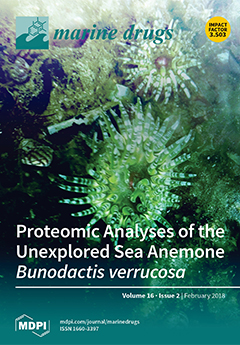Xanthomonas oryzae pv.
oryzae, which causes rice bacterial blight, is one of the most destructive pathogenic bacteria. Biological control against plant pathogens has recently received increasing interest. 1-Deoxy-
N-acetylglucosamine (1-DGlcNAc) was extracted from the supernatant of
Virgibacillus dokdonensis MCCC 1A00493 fermentation
[...] Read more.
Xanthomonas oryzae pv.
oryzae, which causes rice bacterial blight, is one of the most destructive pathogenic bacteria. Biological control against plant pathogens has recently received increasing interest. 1-Deoxy-
N-acetylglucosamine (1-DGlcNAc) was extracted from the supernatant of
Virgibacillus dokdonensis MCCC 1A00493 fermentation through antibacterial bioassay-guided isolation. Its structure was elucidated by LC/MS, NMR, chemical synthesis and time-dependent density functional theory (TD-DFT) calculations. 1-DGlcNAc specifically suppressed
X. oryzae pv.
oryzae PXO99A (MIC was 23.90 μg/mL), but not other common pathogens including
Xanthomonas campestris pv.
campestris str.8004 and
Xanthomonas oryzae pv.
oryzicola RS105. However, its diastereomer (2-acetamido-1,5-anhydro-2-deoxy-
d-mannitol) also has no activity to
X. oryzae pv.
oryzae. This result suggested that activity of 1-DGlcNAc was related to the difference in the spatial conformation of the 2-acetamido moiety, which might be attributed to their different interactions with a receptor. Eighty-four unique proteins were found in
X. oryzae pv.
oryzae PXO99A compared with the genome of strains8004 and RS105 by blastp. There may be unique interactions between 1-DGlcNAc and one or more of these unique proteins in
X. oryzae pv.
oryzae. Quantitative real-time PCR and the pharmMapper server indicated that proteins involved in cell division could be the targets in PXO99A. This research suggested that specificity of active substance was based on the active group and spatial conformation selection, and these unique proteins could help to reveal the specific mechanism of action of 1-DGlcNAc against PXO99A.
Full article






